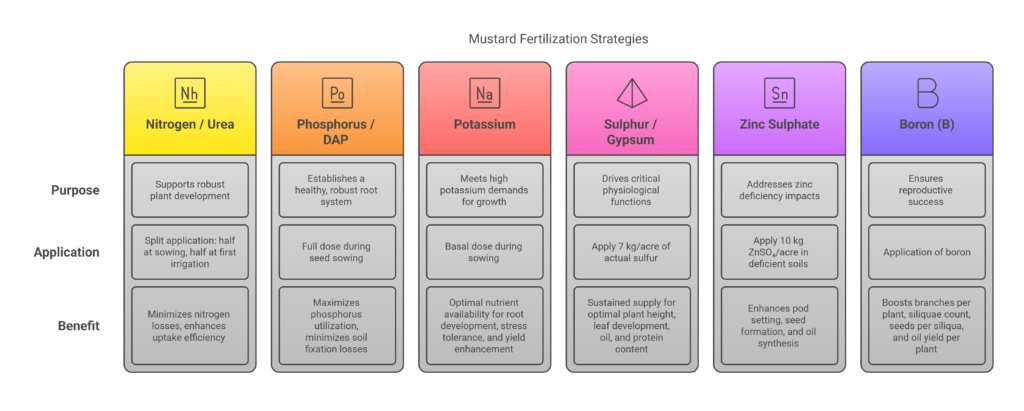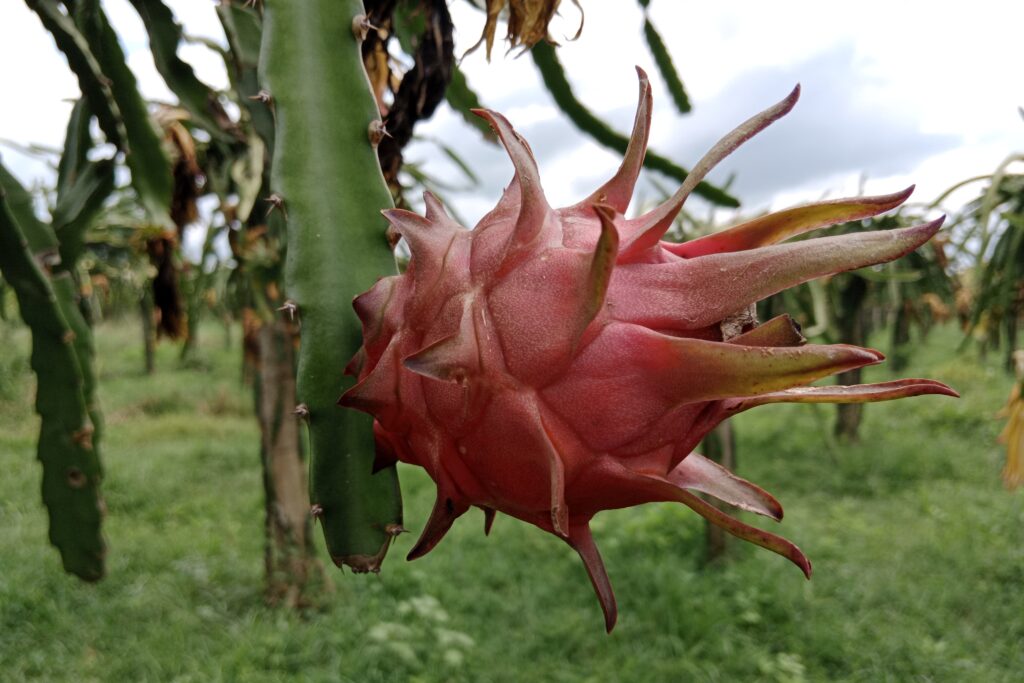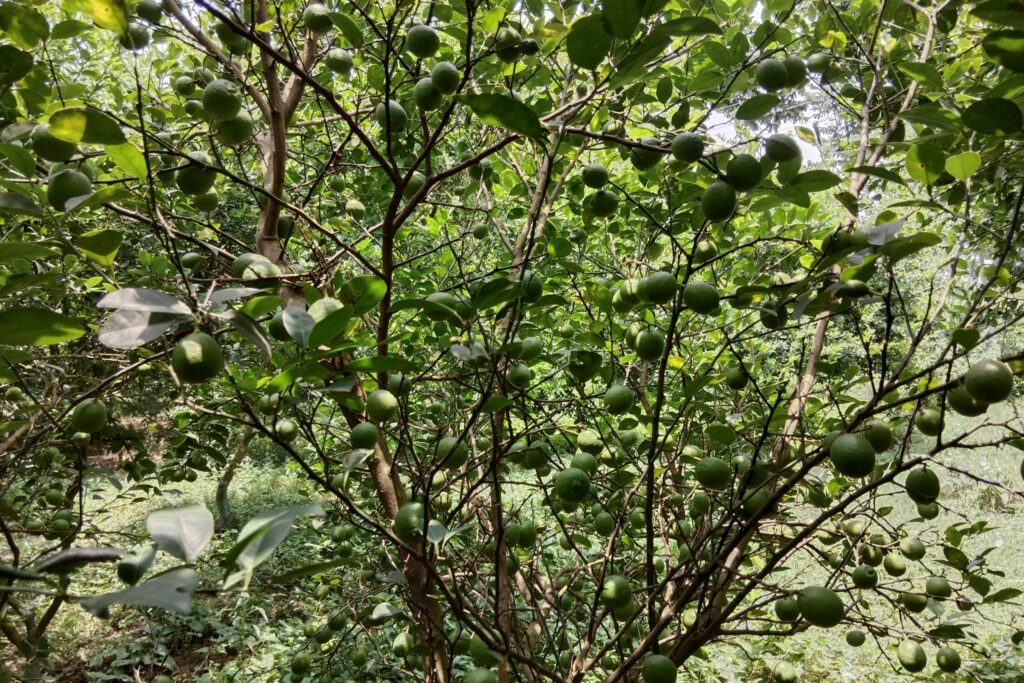Mustard Farming
Mustard farming profit per acre is significantly amplified when adopting hybrid varieties over traditional local strains. Hybrid mustard cultivation generates NRs. 88,000/acre in net profit—66% higher than the NRs. 53,000/acre earned from local varieties—owing to its robust yield of 1,100 kg/acre (vs. 720 kg/acre for local varieties) at a stable market rate of NRs. 125/kg.
While hybrid farming incurs 33.78% higher upfront costs (NRs. 49,500 vs. NRs. 37,000), driven by pricier seeds, fertilizers, irrigation, and harvesting, its 52.78% greater productivity justifies the investment, resulting in a superior profit margin of 177.78% compared to the local variety’s 143.24%. For farmers aiming to maximize mustard farming profit per acre, prioritizing hybrid cultivation is strongly recommended, provided they have access to capital and reliable irrigation infrastructure. This approach ensures optimal returns by balancing elevated costs with substantially higher yields and income.
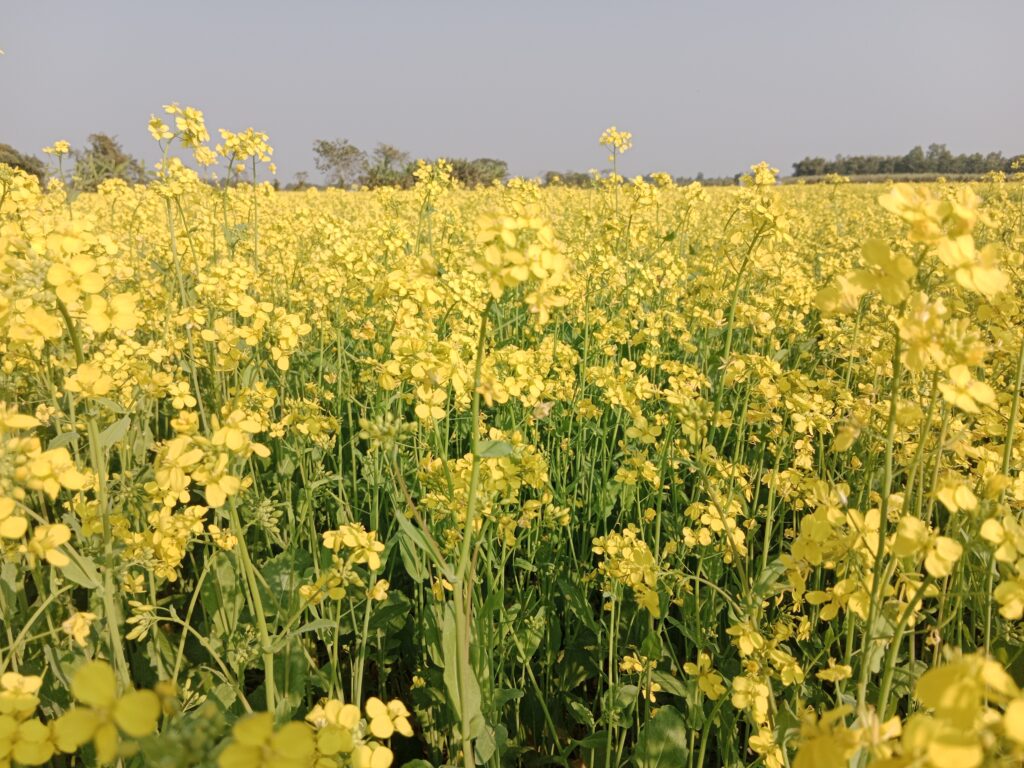
Land Preparation
Successful mustard cultivation begins with thorough land preparation to create optimal soil conditions. The process starts by plowing the field two to three times using tractors or traditional implements, which breaks up the soil into a fine tilth essential for root growth and nutrient absorption. Following plowing, it is crucial to remove all weeds and residual debris from previous crops to eliminate potential habitats for pests and diseases.
Subsequently, the land should be leveled evenly with a plank or harrow to ensure consistent water distribution during irrigation, preventing waterlogging or dry patches. Finally, well-decomposed farmyard manure (FYM) is incorporated into the soil during the final plowing session to enrich soil fertility, providing essential organic matter and nutrients that support healthy mustard plant development.
Soil Type
Mustard cultivation requires well-drained loamy or sandy loam soils with a slightly acidic to neutral pH range of 6.5–7.5, as these conditions promote optimal nutrient availability and root development. While the crop exhibits moderate tolerance to slight salinity, waterlogged or heavy clay soils must be avoided, as poor drainage can lead to root rot and hinder plant growth. Enhancing soil fertility through adequate organic matter content is critical for improving yield, as it boosts soil structure, moisture retention, and microbial activity. Proper drainage systems or soil amendments should also be prioritized to prevent water stagnation, ensuring a balanced growing environment that supports healthy root systems and robust mustard production.
Climatic Requirements
Mustard grows best under cool, dry climatic conditions, with an optimal temperature range of 15–25°C during its growth cycle, though it is highly sensitive to frost, particularly during the flowering stage, which can severely damage blooms and reduce yield. The crop thrives in regions with moderate annual rainfall (400–600 mm) to support vegetative growth, but it requires dry, sunny conditions as the seeds mature to minimize humidity-related diseases like fungal infections and ensure proper pod development. Excess moisture during maturation can lead to lodging, seed spoilage, or pest infestations, making well-distributed rainfall during early growth stages followed by arid post-flowering conditions critical for maximizing productivity and maintaining crop quality.
Major Varieties
| Category | Variety | Maturity (Days) | Yield (qtl/acre) | Oil Content (%) | Special Features |
| Toria Varieties | PBT 37 | 91 | 5.4 | 41.7 | Early maturity; suitable for toria-wheat cultivation; dark brown bold seeds. |
| TL 15 | 88 | 4.5 | N/A | Early maturity. | |
| TL 17 | 90 | 5.2 | N/A | Suitable for multiple cropping. | |
| Raya | RLM 619 | 143 | 8 | 43 | Bold seeds; resistant to white rust, blight, downy mildew; irrigated/rainfed areas. |
| PBR 91 | 145 | 8.1 | N/A | Resistant to blight, rust, and insect pests. | |
| PBR 97 | 136 | 5.2 | 39.8 | Suitable for rainfed conditions; medium bold grains. | |
| PBR 210 | 150 | 6 | N/A | Suitable for timely sown, irrigated conditions. | |
| RLC 3 | 145 | 7.3 | 41.5 | Tall variety. | |
| Gobhi Sarson | GSL 1 | 160 | 6.7 | 44.5 | Short crop; resistant to lodging. |
| PGSH51 | 162 | 7.9 | 44.5 | Tall hybrid; high yielding. | |
| Gobhi Sarson (Canola) | N/A | N/A | N/A | Canola-type oil (health-friendly). | |
| Hyola PAC 401 | 150 | 6.74 | 42 | Medium height; brownish-black seeds. | |
| GSC 6 | N/A | 6.07 | 39.1 | Bold seeds; recommended for irrigated, timely-sown crops. | |
| Indian Mustard | RH 0749 | 146–148 | 10.5–11 | 40 | High-yielding; bold seeds; suitable for Haryana, Punjab, Delhi, North Rajasthan. |
| RH 0406 | 142–145 | 8.8–9.2 | N/A | Suitable for rainfed areas. | |
| T 59 (Varuna) | 145–150 | 6–8 | 39 | Adaptable to all climatic conditions. | |
| Private Varieties | Pioneer 45S42 | 125–130 | 12.5 | N/A | Medium maturity; bold grains; high pod density; suits all soils. |
| Pioneer 45S35 | N/A | 12.5 | N/A | Early maturing; high yielding. | |
| Pioneer 45S46 | N/A | 12.5 | N/A | Medium duration; bold grains; good oil percentage. | |
| Other States | Pusa Agrani | 110 | 7.2 | 40 | Suitable for early/late sown irrigated areas. |
| Pusa Mustard 21 | N/A | 7.2–8.4 | N/A | Timely sown irrigated areas. | |
| Pusa Mustard 24 | N/A | 8–10 | N/A | Timely sown irrigated areas. | |
| NPJ 112 | N/A | 6 | N/A | Suitable for early sown areas. | |
| Pusa Mustard 26 | 126 | 6.4 | N/A | Suitable for late sown areas. | |
| Pusa Mustard 28 | 107 | N/A | 41.5 | High productivity; short maturity. |
Seed Selection
Seed Selection: For optimal crop establishment, begin by selecting certified, disease-free seeds with a minimum germination rate of 85% to ensure viability and minimize disease risks; prioritize plump, uniformly sized seeds to encourage consistent germination, vigorous growth, and improved yields. Prior to planting, treat seeds with fungicides such as Thiram (2–3 grams per kilogram of seeds) to protect against soil-borne pathogens, enhance early seedling health, and establish a resilient, disease-resistant crop foundation critical for long-term productivity.
Seed Rate Per Acre
Local variety: 4–5 kg/acre for broadcasting. Higher rates ensure adequate plant density in poor soils.
Hybrid variety: 2 kg/ acre
Planting
Sow during the rabi season (October–November) to align with cooler temperatures and adequate soil moisture, optimizing germination and early seedling development.
Methods
a). Drilling
To avoid crowding, increase the effectiveness of nitrogen uptake, and facilitate mechanical weeding or harvesting, keep rows 30 to 45 cm apart. To guarantee sufficient soil contact for moisture absorption and to offer protection from environmental stressors, plant seeds two to three centimeters deep. Compared to conventional planting methods, this approach guarantees consistent seed dispersal, reduces competition for resources, and promotes higher yields.
b). Broadcasting
Broadcasting, though widely practiced for its simplicity and reduced labor demands, often leads to uneven seed dispersal, causing irregular plant emergence, heightened competition for nutrients and sunlight, and suboptimal yields due to overcrowded or sparse crop patches; while this method suits small-scale or resource-constrained farming, its inefficiencies in spacing and growth uniformity make it less ideal for maximizing productivity compared to systematic approaches like drilling.
Irrigation
Initiate irrigation 30–35 days after sowing to coincide with critical crop growth stages (e.g., flowering or root development), ensuring adequate soil moisture for optimal nutrient uptake and stress mitigation; apply 5–7 cm of water per session via flood or drip methods, adjusting frequency based on soil type (e.g., sandy soils may require more frequent watering) and weather conditions. Timely irrigation at this phase supports robust vegetative growth, reduces drought-induced yield losses, and maintains uniform crop health.
Fertilizer and Manure
For optimal oilseed crop nutrition, apply a basal dose of 10–15 tonnes of farmyard manure (FYM) per acre during soil preparation to enhance organic matter and nutrient availability; however, research emphasizes that oilseed crops disproportionately deplete soil sulfur (S), absorbing 12 kg of S per tonne of grain—far exceeding cereals (3–4 kg) and pulses (8 kg)—due to their reliance on sulfur-rich compounds like oils and proteins.
To counteract this depletion and sustain soil health, integrate targeted sulfur supplements such as ammonium sulfate or gypsum into fertilization regimes, ensuring replenished soil reserves, maintained yield potential, and prevention of long-term fertility degradation in oilseed-focused agricultural systems.
a). Nitrogen / Urea
For optimal nitrogen management, apply ammonium sulfate as the preferred nitrogenous fertilizer, with half the recommended dose (50 kg urea/acre) drilled into the soil during sowing to ensure root-accessible nutrient availability; the remaining half (50 kg urea/acre) should be top-dressed during the first irrigation (30–35 days post-sowing) to align with peak vegetative growth demands. This split-application strategy minimizes nitrogen losses (e.g., leaching, volatilization), enhances uptake efficiency, and supports robust plant development while maintaining soil fertility.
b). Phosphorus / DAP
Phosphorus (P) is critical for establishing a healthy, robust root system, enabling efficient nutrient and water uptake; apply the full recommended dose of 72 kg DAP per acre during seed sowing through drilling or basal placement to ensure immediate availability for early root development. This single-time application at planting maximizes phosphorus utilization, minimizes soil fixation losses, and supports vigorous vegetative growth, laying the foundation for optimal crop productivity.
c). Potassium
Mustard demands substantial potassium (K) for growth, though only 20% of absorbed K is retained in seeds, with the remaining 80% stored in leaves and stems that decompose and recycle K back into the soil post-harvest. To meet this high requirement, apply 16 kg of muriate of potash (MOP) per acre during sowing as a basal dose, ensuring optimal nutrient availability for root development, stress tolerance, and yield enhancement. This practice leverages the crop’s natural K recycling while addressing immediate needs for robust plant performance.
d). Sulphur / Gypsum
Gypsum, a fertilizer containing 22% calcium and 18% sulfur, is vital for mustard cultivation, as sulfur drives critical physiological functions—synthesizing cysteine, methionine, chlorophyll, and oil content, activating enzymes, and forming flavor compounds in crucifers like mustard. Brassica species, with their high sulfur demand due to sulfur-rich glucosinolates, require consistent sulfate-S (SO₄-S) availability, peaking during flowering.
To meet this, apply 7 kg/acre of actual sulfur (via ammonium sulfate) or gypsum (14% S), ensuring sustained supply for optimal plant height, leaf development, oil (↑3–5%), and protein content. Notably, oilseeds remove 12 kg sulfur per tonne of grain—fourfold higher than cereals (3 kg)—making targeted sulfur application essential to boost oil yield in mustard and rapeseed while replenishing soil reserves depleted by intensive cropping.
e). Zinc sulphate
Zinc deficiency critically impacts winter crops like mustard, as low soil temperatures reduce zinc availability and high phosphorus soils exacerbate depletion, particularly in intensive cropping systems.
Applying 10 kg ZnSO₄/acre in deficient soils addresses these challenges, as zinc is vital for synthesizing enzymes, regulating metabolic processes (e.g., RNA and chlorophyll production), and stimulating growth hormones (auxin/IAA) that drive root/shoot development, starch formation, and seed maturation. In mustard, zinc enhances pod setting, seed formation, and oil synthesis, counteracting deficiency symptoms like stunted growth and chlorosis, while restoring soil health to sustain yield potential in zinc-depleted agroecosystems.
f). Boron (B)
Boron is essential for mustard reproductive success, as its deficiency leads to pollen abortion, severely compromising seed set and yield; application of boron significantly enhances productivity by boosting branches per plant, siliquae (pods) count, seeds per siliqua, and oil yield per plant, ensuring optimal flower fertility, pod development, and seed filling. This micronutrient also improves nutrient translocation and cell wall integrity, directly amplifying both quantitative (seed yield) and qualitative (oil content) outcomes in boron-deficient soils.
Weed Control
Effective weed management is critical during the first 30–40 days post-sowing, as weeds aggressively compete for nutrients, water, and light; apply pre-emergence herbicides like pendimethalin (1 kg/acre) or conduct timely hand-weeding to suppress early weed growth. Complement these measures with inter-cultivation using a hoe at 3–4 weeks to disrupt weed resurgence, enhance soil aeration, and improve root zone conditions, ensuring minimal competition and optimal resource allocation for robust crop establishment and yield stability.
Pest and Disease Management
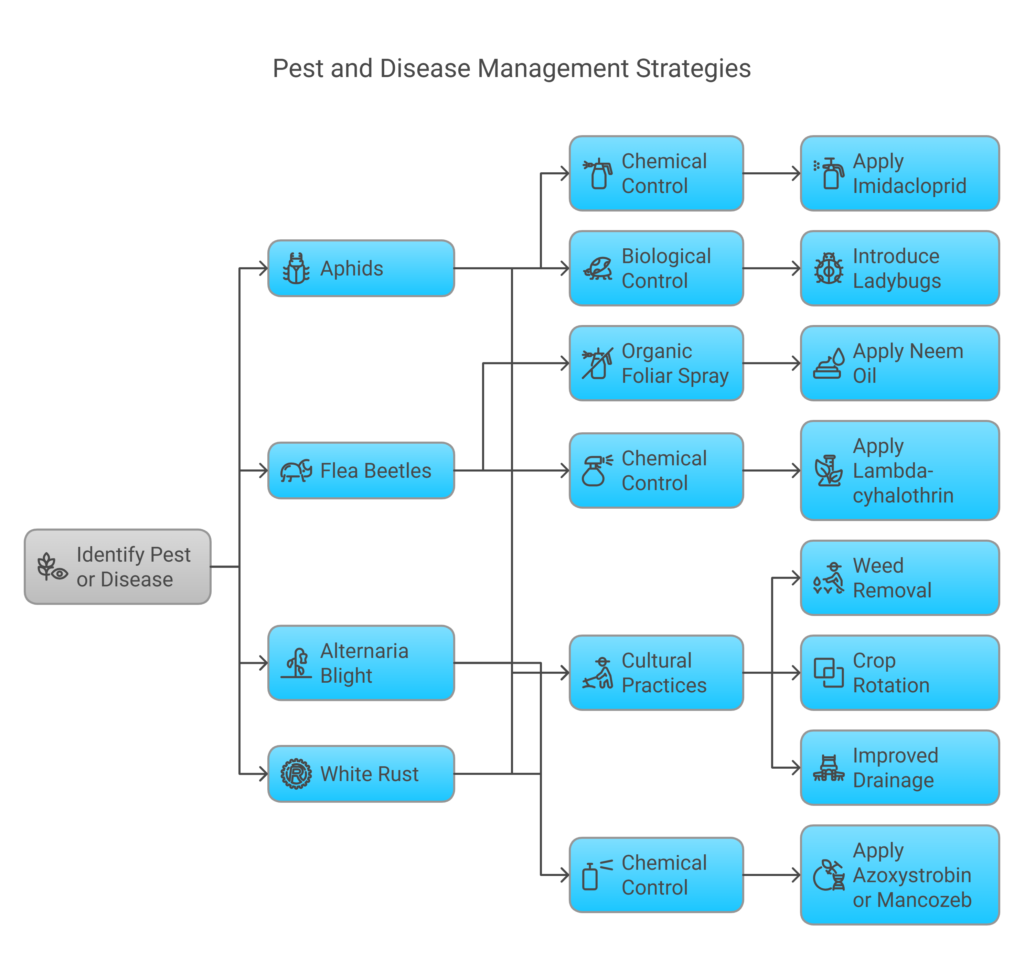
Common Pests
a). Aphids
Aphids damage crops by sucking sap from leaves and shoots, leading to yellowing, stunted growth, and honeydew secretion that fosters sooty mold growth, severely reducing photosynthesis and yield; to manage infestations, apply Imidacloprid (0.5–1 ml/liter) as an early chemical intervention, introduce natural predators like ladybugs or lacewings for biological control, and adopt cultural practices such as weed removal and avoiding excessive nitrogen fertilization to deter aphid proliferation.
b). Flea Beetles
Flea beetles harm crops as adults create small holes in leaves and larvae damage roots, reducing plant vigor and causing seedling death; to control infestations, apply neem oil (2–3 ml/liter) as an organic foliar spray to deter feeding, use lambda-cyhalothrin for severe outbreaks, and implement cultural practices like crop rotation and row covers to shield seedlings from beetle attacks.
Common Diseases
a). Alternaria Blight
Alternaria Blight, a fungal disease, manifests as dark brown concentric ring spots on leaves, stems, and pods, leading to premature defoliation and shriveled seeds; it thrives under high humidity (>80%) and warm temperatures (25–30°C). To combat this, spray Azoxystrobin (0.1%) or Mancozeb (0.2%) at 10-day intervals for chemical control, while cultural practices like destroying infected crop residues, avoiding dense planting, and using resistant varieties reduce spore survival and spread, ensuring minimized crop damage and sustained yield.
b). White Rust
White Rust, triggered by the fungus Albugo candida, is identified by chalky white pustules on the lower leaf surfaces, distorted flowers, and swollen stems, favoring cool (10–20°C), moist environments with stagnant air. For effective control, use preemptive fungicides like Mancozeb (0.2%) or Metalaxyl-Mancozeb blends to block spore activation and fungal progression.
Culturally, prioritize improved drainage systems, switch to drip irrigation to reduce foliage moisture, and adopt rotational planting with non-susceptible crops (e.g., grains). These steps break the pathogen’s lifecycle by limiting damp conditions that sustain spores and curb soil-borne pathogen persistence, effectively lowering disease incidence and promoting healthier crop outcomes.
Harvesting
Harvest mustard when pods turn yellowand seeds produce a rattling sound (130–160 days post-sowing) to ensure optimal maturity; manually cut plants using sickles, allow them to dry for 5–7 days in the field to reduce moisture, and then thresh to separate seeds. Delayed harvesting risks pod shattering, leading to seed loss, while mechanical harvesting streamline large-scale operations by combining cutting, threshing, and cleaning in a single pass, enhancing efficiency and minimizing post-harvest losses for higher yield retention.
Yield Per Acre
Under optimal cultivation practices, mustard crops yield 8–12 quintals (800–1200 kg) per acre, with hybrid varieties potentially reaching 15 quintals/acre under ideal conditions. Achieving these outputs hinges on integrated pest management, timely irrigation, and precision nutrient application (e.g., sulfur, zinc, and boron supplementation), which collectively enhance plant vigor, pod formation, and seed quality. Strategic adoption of hybrids, combined with mechanized harvesting to minimize losses, ensures farmers maximize both yield quantity and economic returns in sustainable production systems.
Cost of Investment for mustard farming per Acre
| S.N. | Categories | Local Variety (NRs.) | Hybrid Variety (NRs.) |
| 1 | Land Preparation (plowing, leveling) | 10,000 | 10,000 |
| 2 | Seed rate per acre | 1,000 | 2,500 |
| 3 | Labor Costs (sowing) | 2,000 | 2,000 |
| 4 | Fertilizers and Manure | 7,000 | 10,000 |
| 5 | Irrigation | 3,000 | 5,000 |
| 6 | Weed Control (pre & post-emergence) | 2,000 | 2,000 |
| 7 | Pest & Disease Control | 2,000 | 3,000 |
| 8 | Harvesting & Threshing | 7,000 | 10,000 |
| 9 | Miscellaneous Costs | 3,000 | 5,000 |
| Total Cost | 37,000 | 49,500 |
Income from one acre mustard farming
| Variety | Yield/acre | Market Price (NRs/kg) | Total Income (NRs.) |
| Local Mustard | 720 kg | 125 | 90,000 |
| Hybrid Mustard | 1,100 kg | 125 | 137,500 |
Analysis of Mustard Farming Profit Per Acre
| Parameter | Local Variety (NRs.) | Hybrid Variety (NRs.) |
| Total Income | 90,000 | 137,500 |
| Total Cost | 37,000 | 49,500 |
| Net Profit | 53,000 | 88,000 |
| Profit Margin (%) | 143.24% | 177.78% |
Hybrid mustard farming is substantially more profitable, generating 88,000 NRs/acre in net profit—a 66% increase compared to the local variety’s 53,000 NRs/acre—and achieving a superior profit margin of 177.78% versus 143.24%. Although hybrid cultivation incurs 33.78% higher costs (NRs. 49,500 vs. 37,000) due to expenses on seeds, fertilizers, irrigation, and harvesting, it delivers 52.78% more yield (1,100 kg vs. 720 kg), making the additional investment worthwhile. Farmers with sufficient capital and irrigation access are advised to prioritize hybrid mustard farming for maximized returns.

